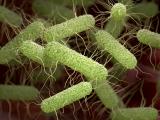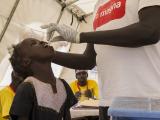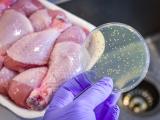Editor's note: In a statement released late on Jul 30, the FDA said that the Mexican farm where the contaminated jalapeno pepper found in Texas last week was grown is not the same one where the contaminated irrigation water and Serrano pepper were found, contrary to the report below. The farm where the contaminated Serrano pepper and irrigation water were found is in the state of Nuevo Leon and was identified through the trace-back of products linked to clusters of cases in the United States, the agency said. The FDA said the contaminated jalapeno found at a produce distributor in McAllen, Tex., was traced back to a different farm in Mexico; the location was not disclosed.
Jul 30, 2008 (CIDRAP News) A Salmonella-tainted jalapeno pepper found last week in Texas has been traced to a Mexican farm, and investigators have found the outbreak strain of Salmonella in irrigation water there, a Food and Drug Administration (FDA) official told Congress today.
David W. Acheson, MD, the FDA's associate commissioner for foods, told a House subcommittee this afternoon that the contaminated jalapeno pepper found last week at a distribution center in McAllen, Tex., was traced back to the farm in Mexico.
"Two hours ago we learned that we had got a positive sample in water used for irrigation" and also in a Serrano pepper on the farm, Acheson told the House Agriculture Subcommittee on Horticulture and Organic Agriculture, at a hearing that was streamed over the Web.
"We found a positive in Serrano peppers and we're recommending that consumers not only not consume jalapeno peppers but also Serrano peppers," Acheson said.
The FDA first warned about possible Salmonella in jalapeno and Serrano peppers on Jul 9, after investigations of several case clusters pointed in that direction. Certain kinds of tomatoes were previously the main suspects in the outbreak, and investigators have not yet excluded a possible role for them early in the outbreak. A warning against eating tomatoes was canceled on Jul 17.
The outbreak has grown to 1,319 cases in 43 states, along with Washington, DC, and Canada, Dr. Lonnie King of the Centers for Disease Control and Preveniton (CDC) reported at the hearing, which focused on the problems in tracing fresh produce in connection with disease outbreaks.
Acheson said the contaminated jalapeno found at the Texas distributor was traced back through two different facilities in Mexico and finally to the farm, whose location he didn't disclose. He said the farm distributes produce to "a number of other places" and added that the FDA investigators would try to identify those.
The discovery of the first piece of produce actually linked to a case in the outbreak was announced just 2 days ago by Colorado officials, who found the outbreak strain in a jalapeno from the home of a southwestern Colorado resident who had been sick.
Today's congressional hearing was the first of two this week scheduled to focus on the outbreak and the response to it. Members of the subcommittee sharply questioned Acheson and King about various aspects of the outbreak investigation.
Rep. Dennis Cardoza, D-Calif., chair of the subcommittee, set the tone at the beginning: "The investigation faltered almost from the beginning as investigators began asking patients what they ate before they became ill," he said. "They used questionnaires that listed major food items but not all food items." For example, the form included peppers but not jalapeno peppers specifically.
"Frankly, I'd just like to hear what went wrong," Cardoza said.
Under questioning by Cardoza, Acheson acknowledged that no contaminated tomatoes have been found, despite the weeks of warnings against eating certain kinds.
When Cardoza asked if the warning on tomatoes was "an erroneous callout by your agency," Acheson said, "No, there was a very clear, methodical scientific process whereby the CDC reached a statistical conclusion it was tomatoes."
Though no contaminated tomatoes have been found, Acheson said, "We have found contaminated jalapeno and Serrano peppers and have found . . . common distribution points. We've also identified a farm where all three are grown. So the possibility exists that this was on more than one commodity; we already know it's two, so it could've been three."
Under questioning by Rep. Tim Mahoney, D-Fla., Acheson said there is no evidence that any tomatoes now on the market are contaminated, but the FDA can't exclude the possibility that tomatoes played some role earlier in the outbreak.
When Mahoney asked if there are any required inspections of the implicated farm in Mexico, Acheson said, "There's not a requirement that I'm aware of for anyone to inspect those farms."
Later, he said about 1% of food items imported into the United States are "physically examined by an inspector." Inspections and testing of imported foods are largely driven by the record of past problems, such as Salmonella in cantaloupe, he explained.
See also:
House Agriculture Committee's hearing schedule
http://democrats.agriculture.house.gov/hearings/schedule.html
Jul 30 FDA statement
http://www.fda.gov/NewsEvents/Newsroom/PressAnnouncements/2008/ucm116916.htm

















